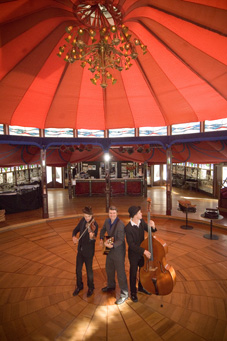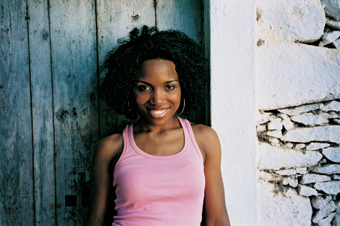 |
Mikelangelo and the Black Sea Gentleman in the Pacific Crystal Palace photo Matt Newton |
Mikelangelo and the Black Sea Gentleman
They must have put something in the water in Canberra which produced a generation of wild and wonderful performance groups and bands: Splinters, The Bedridden and P.Harness all share a fantastical, chaotic humour, with more than a waft of feral exuberance. Once the barely clad thrust behind P.Harness, Michael Simic (Mikelangelo) has cleaned up his act over the years, left the nation's capital and now appears immaculately suited and slicked, leading his Black Sea Gentleman through a Balkan cabaret of parodic ballads and dark entertainments.
The lyrics are BLACK. One song is introduced as a ‘rumination on gloom’; another talks of ‘skeletons on a beach of flesh, drowning in a sea of organs, with lapping waves of blood.’ But somehow it’s all rather amusing. Mikelangelo has the charm of a Croatian Elvis, with constant banter, and audience provocation. Other band members also have their moment—Muldavio, the clarinettist, recites a poem about his days as a taxidermist to the rich, while Guido Libido, the accordion player, ‘performs’ a silent movie in front of a blank screen with a strobe light. They are also fine musicians, pillaging styles from around Europe, swinging between Parisian chanson, gypsy polka and Yiddish lament. In a quick slip across the Atlantic there is even a Western epic. By the end, of course we are singing along, and yearning for real or imagined European roots. If you can’t afford the airfare you should check out Canberra.
 |
Lura photo Deborah Metsch |
Lura
Lura hails from Lisbon but now lives in Cape Verde on the West Coast of Africa. In her concert she takes us on a tour of the rhythms of her country. She is a diminutive figure with a big voice, warm and liquid in her lower registers, full bodied and punchy in her upper range. Backed by a band of piano, guitar, bass, drums and other percussion, the music is energetic but with a hint a of world weary melancholy. Lura is charming and persuasive, at one point encouraging us to repeat a word after her. She then reveals we’ve been saying “Vaseline” with a Portuguese accent—African hair gets very dry she tells us with a wry grin.
Most haunting were the songs that used the batuku rhythm—those belonging to women. These are slower songs, in which Lura drums on a kind of cushion of folded cloth. The instrumentation is sparser allowing us to appreciate her expressive nuances and gorgeous tone.
And of course there must be dancing. To conclude the show, Lura removes her shoes, ties a swathe of material around her hips, turns her back to us and shakes her booty. The smouldering sexuality that we have been sensing now breaks through as she manipulates the drummer with hip lifts and drops and stamps. Then it is our turn to dance (which you kind of wanted to do all along) and we shuffle between the chairs and tables of the Crystal Palace. Maybe next time we see Lura, the audience should be able to dance for the whole show—it certainly enhances the enjoyment of those hypnotic Cape Verde rhythms.
Christine Anu
Christine Anu appears in a sparkling caftan, thick curly black hair adorned with a massive frangipani. She tells us she is from the Saltwater people—of the swamp bird and the shark—and she welcomes us with an unaccompanied traditional song. And then she and the band launch straight in: “without a word of warning the blues came in this morning.”
Black is Blue combines blues standards with originals, joined by little anecdotes and reflections—Anu dawdling to church and slipping in late; her favourite scenes from The Color Purple; sharing how “the blues is a state of mind.” She does some fine renditions of Wade in the Water, Sister and Night Time is the Right Time interspersed with new songs, one particularly beautiful—My Grandma’s Hands—talking of the strength, comfort and guidance of her grandmother when Anu was growing up on Mobiac Island in the Torres Strait.
She has a big, gutsy voice and she’s not afraid to belt it out. In the second half, she curiously dons an oversized afro wig and the songs seem to get bigger, and brasher. Her tone in Georgia on my Mind, and Hold On becomes relentlessly strident, losing warmth and subtlety. But she recovers them for Fever and No Woman No Cry. Of course, as Neil Murray’s My Island home is the theme song of Ten Days on the Island, she couldn’t leave us without that, and considering the cringe I experience due to its hijacking for marketing purposes, it still holds its own as a strong and soulful song.
Anu is a polished performer and Black is Blue is slick and controlled, each segué and audience excursion meticulously prepared, falling just short of contrived. The initial format of standard followed by original provided a clear structure, allowing for some strong connections and resonances that unfortunately thinned out in the second half. As far as the fake afro for the entire second part including encore? Even in bad hair Christine Anu is a fine performer who gave her audience just what they wanted.
Mikelangelo and the Black Sea Gentleman, March 25-27, Lura, March 25-26, Christine Anu, March 28-29, The Pacific Crystal Palace, Hobart, Ten Days on the Island
Gail Priest is the Associate Editor of RealTime.
© Gail Priest; for permission to reproduce apply to [email protected]








 back
back